Characteristics of PM10 Levels Monitored in Bangkok and Its Vicinity Areas, Thailand
Abstract
1. Introduction
2. Materials and Methods
2.1. Air Sampling Site
2.2. Air Sampling Procedure
2.3. TEM-EDS Characterizations
2.4. Data Analysis
3. Results and Discussions
3.1. Ambient Concentration of PM10
3.2. Comparison of the PM10 Concentrations with Other Studies
3.3. Morphology and Chemical Composition of PM10
4. Conclusions
Author Contributions
Funding
Acknowledgments
Conflicts of Interest
References
- Punsompong, P.; Chantara, S. Identification of potential sources of PM10 pollution from biomass burning in northern Thailand using statistical analysis of trajectories. Atmos. Pollut. Res. 2018, 9, 1038–1051. [Google Scholar] [CrossRef]
- Zhou, L.; Su, X.; Li, B.; Chu, C.; Sun, H.; Zhang, N.; Han, B.; Li, C.; Zou, B.; Niu, Y.; et al. PM2.5 exposure impairs sperm quality through testicular damage dependent on NALP3 inflammasome and miR-183/96/182 cluster targeting FOXO1 in mouse. Ecotoxicol. Environ. Saf. 2019, 169, 551–563. [Google Scholar] [CrossRef] [PubMed]
- Khodeir, M.; Shamy, M.; Alghamdi, M.; Zhong, M.; Sun, H.; Costa, M.; Chen, L.-C.; Maciejczyk, P. Source apportionment and elemental composition of PM2.5 and PM10 in Jeddah City, Saudi Arabia. Atmos. Pollut. Res. 2012, 3, 331–340. [Google Scholar] [CrossRef] [PubMed]
- Xing, Y.-F.; Xu, Y.-H.; Shi, M.-H.; Lian, Y.-X. The impact of PM2.5 on the human respiratory system. J. Thorac. Dis. 2016, 8, E69–E74. [Google Scholar] [CrossRef]
- Wilczyńska-Michalik, W.; Gasek, R.; Michalik, M.; Dańko, J.; Plaskota, T. Mineralogy, chemical composition and leachability of ash from biomass combustion and biomass–coal co-combustion. Mineralogia 2018, 49, 67–97. [Google Scholar] [CrossRef]
- Apeagyei, E.; Bank, M.S.; Spengler, J.D. Distribution of heavy metals in road dust along an urban-rural gradient in Massachusetts. Atmos. Environ. 2011, 45, 2310–2323. [Google Scholar] [CrossRef]
- Damek-Poprawa, M.; Sawicka-Kapusta, K. Histopathological changes in the liver, kidneys, and testes of bank voles environmentally exposed to heavy metal emissions from the steelworks and zinc smelter in Poland. Environ. Res. 2004, 96, 72–78. [Google Scholar] [CrossRef]
- Bharti, S.K.; Kumar, D.; Anand, S.; Poonam; Barman, S.C.; Kumar, N. Characterization and morphological analysis of individual aerosol of PM10 in urban area of Lucknow, India. Micron 2017, 103, 90–98. [Google Scholar] [CrossRef]
- D’Evelyn, S.M.; Vogel, C.F.A.; Bein, K.J.; Lara, B.; Laing, E.A.; Abarca, R.A.; Zhang, Q.; Li, L.; Li, J.; Nguyen, T.B.; et al. Differential inflammatory potential of particulate matter (PM) size fractions from imperial valley, CA. Atmos. Environ. 2021, 244, 117992. [Google Scholar] [CrossRef]
- Vongruang, P.; Pimonsree, S. Biomass burning sources and their contributions to PM10 concentrations over countries in mainland Southeast Asia during a smog episode. Atmos. Environ. 2020, 228, 117414. [Google Scholar] [CrossRef]
- Wu, Z.; Liu, F.; Fan, W. Characteristics of PM10 and PM2.5 at Mount Wutai Buddhism Scenic Spot, Shanxi, China. Atmosphere 2015, 6, 1195–1210. [Google Scholar] [CrossRef]
- Labrada-Delgado, G.; Aragon-Pina, A.; Campos-Ramos, A.; Castro-Romero, T.; Amador-Munoz, O.; Villalobos-Pietrini, R. Chemical and morphological characterization of PM2.5 collected during MILAGRO campaign using scanning electron microscopy. Atmos. Pollut. Res. 2012, 3, 289–300. [Google Scholar] [CrossRef]
- Liati, A.; Schreiber, D.; Lugovyy, D.; Gramstat, S.; Dimopoulos Eggenschwiler, P. Airborne particulate matter emissions from vehicle brakes in micro- and nano-scales: Morphology and chemistry by electron microscopy. Atmos. Environ. 2019, 212, 281–289. [Google Scholar] [CrossRef]
- Hodson, D.L.R.; Sutton, R.T. Exploring multi-model atmospheric GCM ensembles with ANOVA. Clim. Dyn. 2008, 31, 973–986. [Google Scholar] [CrossRef]
- Chattopadhyay, G.; Chattopadhyay, S. A probe into the chaotic nature of total ozone time series by correlation dimension method. Soft Comput. 2008, 12, 1007–1012. [Google Scholar] [CrossRef]
- Chattopadhyay, S.; Chattopadhyay-Bandyopadhyay, G. Forecasting daily total ozone concentration—a comparison between neurocomputing and statistical approaches. Int. J. Remote Sens. 2008, 29, 1903–1916. [Google Scholar] [CrossRef]
- Navaporn Kanjanasiranont, T.P.; Narut, S. Ambient and Indoor PM10 and PM10-bound PAHs around the Vicinity of an Industrial Estate in Rayong, Thailand: Concentration and Source Identification. Appl. Environ. Res. 2021, 43, 15–29. [Google Scholar] [CrossRef]
- Majumder, A.K.; Nazmul Islam, K.M.; Bajracharya, R.M.; Carter, W.S. Assessment of occupational and ambient air quality of traffic police personnel of the Kathmandu valley, Nepal; in view of atmospheric particulate matter concentrations (PM10). Atmos. Pollut. Res. 2012, 3, 132–142. [Google Scholar] [CrossRef][Green Version]
- Karimi, B.; Shokrinezhad, B. Spatial variation of ambient PM2.5 and PM10 in the industrial city of Arak, Iran: A land-use regression. Atmos. Pollut. Res. 2021, 12, 101235. [Google Scholar] [CrossRef]
- Ahmad, I.; Khan, B.; Khan, S.; Rahman, Z.u.; Khan, M.A.; Gul, N. Airborne PM10 and lead concentrations at selected traffic junctions in Khyber Pakhtunkhwa, Pakistan: Implications for human health. Atmos. Pollut. Res. 2019, 10, 1320–1325. [Google Scholar] [CrossRef]
- Wang, J.; Hu, Z.; Chen, Y.; Chen, Z.; Xu, S. Contamination characteristics and possible sources of PM10 and PM2.5 in different functional areas of Shanghai, China. Atmos. Environ. 2013, 68, 221–229. [Google Scholar] [CrossRef]
- Buseck, P.R.; Adachi, K.; Gelencsér, A.; Tompa, É.; Pósfai, M. Are black carbon and soot the same? Atmos. Chem. Phys. Discuss. 2012, 2012, 24821–24846. [Google Scholar] [CrossRef]
- Jabłońska, M.; Janeczek, J. Identification of industrial point sources of airborne dust particles in an urban environment by a combined mineralogical and meteorological analyses: A case study from the Upper Silesian conurbation, Poland. Atmos. Pollut. Res. 2019, 10, 980–988. [Google Scholar] [CrossRef]
- Shahid, I.; Kistler, M.; Mukhtar, A.; Ghauri, B.M.; Ramirez-Santa Cruz, C.; Bauer, H.; Puxbaum, H. Chemical characterization and mass closure of PM10 and PM2.5 at an urban site in Karachi–Pakistan. Atmos. Environ. 2016, 128, 114–123. [Google Scholar] [CrossRef]
- Clifford, S.; Mazaheri, M.; Salimi, F.; Ezz, W.N.; Yeganeh, B.; Low-Choy, S.; Walker, K.; Mengersen, K.; Marks, G.B.; Morawska, L. Effects of exposure to ambient ultrafine particles on respiratory health and systemic inflammation in children. Environ. Int. 2018, 114, 167–180. [Google Scholar] [CrossRef]
- da Costa e Oliveira, J.R.; Base, L.H.; de Abreu, L.C.; Filho, C.F.; Ferreira, C.; Morawska, L. Ultrafine particles and children’s health: Literature review. Paediatr. Respir. Rev. 2019, 32, 73–81. [Google Scholar] [CrossRef] [PubMed]
- Guo, L.; Johnson, G.R.; Hofmann, W.; Wang, H.; Morawska, L. Deposition of ambient ultrafine particles in the respiratory tract of children: A novel experimental method and its application. J. Aerosol Sci. 2020, 139, 105465. [Google Scholar] [CrossRef]
- Moreno-Ríos, A.L.; Tejeda-Benítez, L.P.; Bustillo-Lecompte, C.F. Sources, characteristics, toxicity, and control of ultrafine particles: An overview. Geosci. Front. 2021, 13, 101147. [Google Scholar] [CrossRef]
- Hernández-Pellón, A.; Mazón, P.; Fernández-Olmo, I. Quantification of manganese species in particulate matter collected in an urban area nearby a manganese alloy plant. Atmos. Environ. 2019, 205, 46–51. [Google Scholar] [CrossRef]
- Hao, Y.; Gao, C.; Deng, S.; Yuan, M.; Song, W.; Lu, Z.; Qiu, Z. Chemical characterisation of PM2.5 emitted from motor vehicles powered by diesel, gasoline, natural gas and methanol fuel. Sci. Total Environ. 2019, 674, 128–139. [Google Scholar] [CrossRef]
- Lu, Z.; Deng, S.; Liu, X.; Huang, L.; Zhang, R.; Song, H.; Li, G. Morphology and composition of particles emitted from conventional and alternative fuel vehicles. Environ. Sci. Pollut. Res. 2021, 28, 19810–19821. [Google Scholar] [CrossRef] [PubMed]
- Genga, A.; Baglivi, F.; Siciliano, M.; Siciliano, T.; Tepore, M.; Micocci, G.; Tortorella, C.; Aiello, D. SEM-EDS investigation on PM10 data collected in Central Italy: Principal Component Analysis and Hierarchical Cluster Analysis. Chem. Cent. J. 2012, 6, S3. [Google Scholar] [CrossRef]
- Karin, P.; Koko, P.; Charoenphonphanich, C.; Chollacoop, N.; Hanamura, K. Physicochemical Characterization of Diesel Engine’s Soot and Metal Oxide Ash Nanoparticles Using Electron Microscopy, EDS and TGA. Emiss. Control. Sci. Technol. 2021, 7, 91–104. [Google Scholar] [CrossRef]
- Kostenidou, E.; Martinez-Valiente, A.; R’Mili, B.; Marques, B.; Temime-Roussel, B.; Durand, A.; André, M.; Liu, Y.; Louis, C.; Vansevenant, B.; et al. Technical note: Emission factors, chemical composition, and morphology of particles emitted from Euro 5 diesel and gasoline light-duty vehicles during transient cycles. Atmos. Chem. Phys. 2021, 21, 4779–4796. [Google Scholar] [CrossRef]
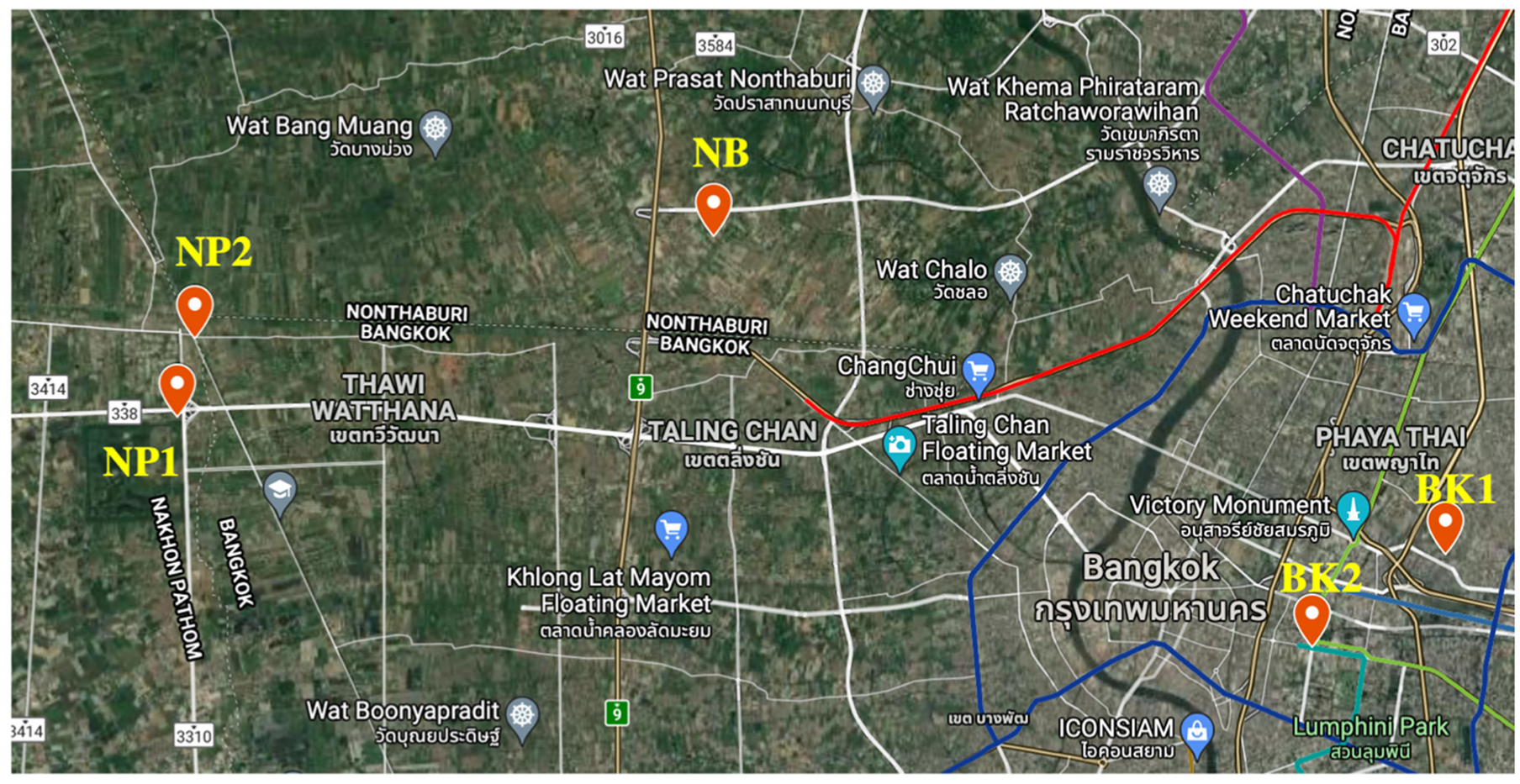
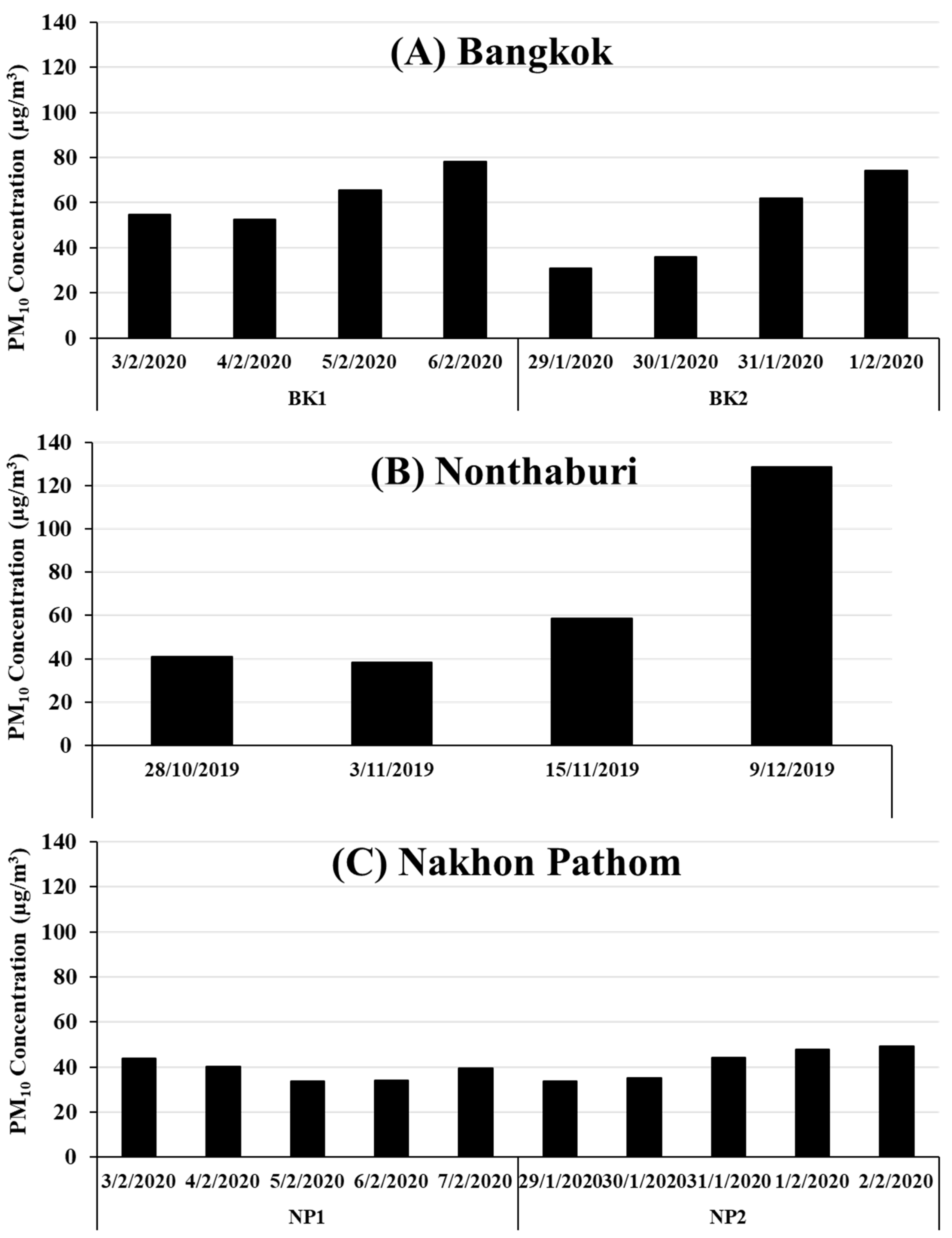
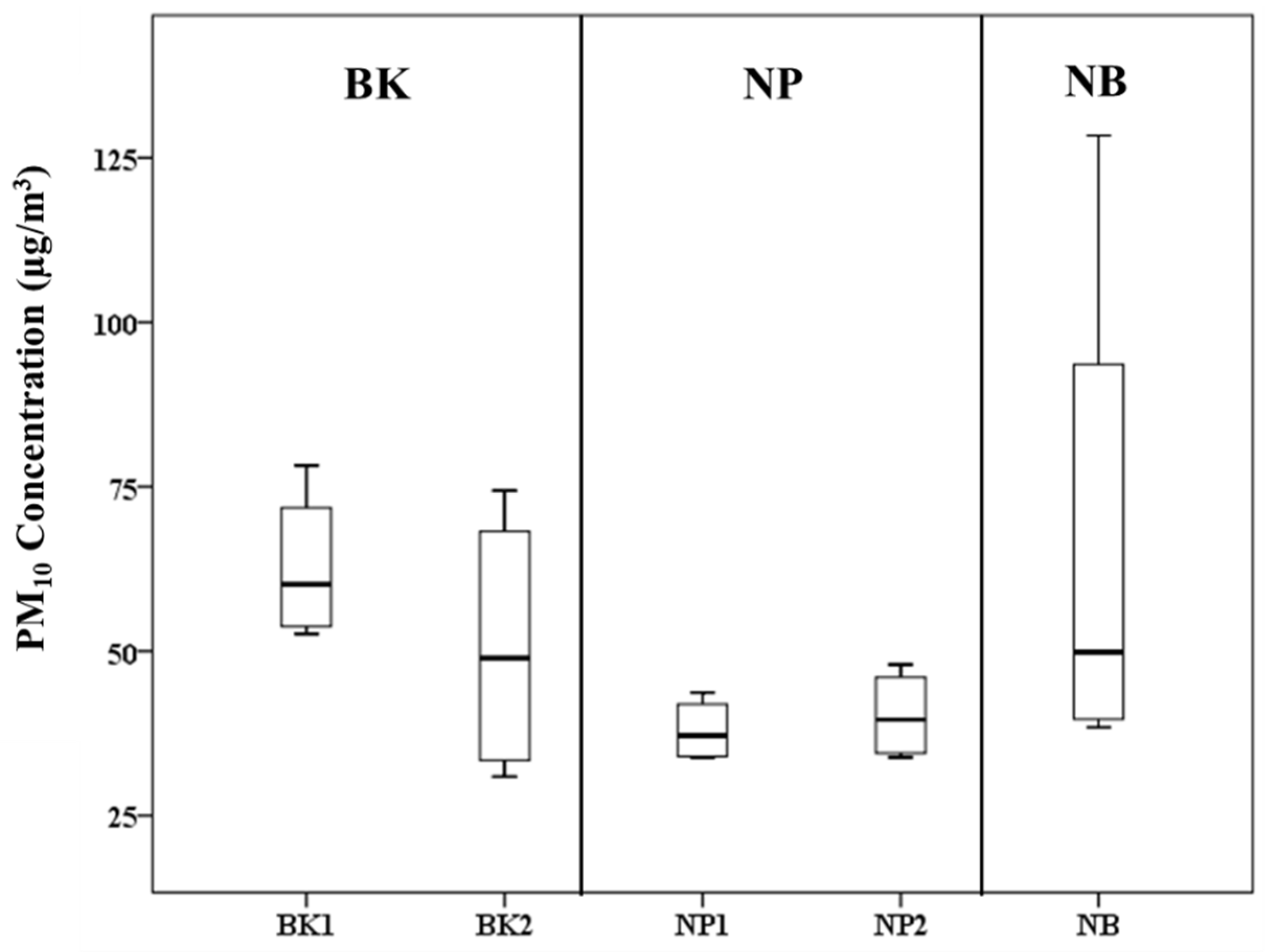
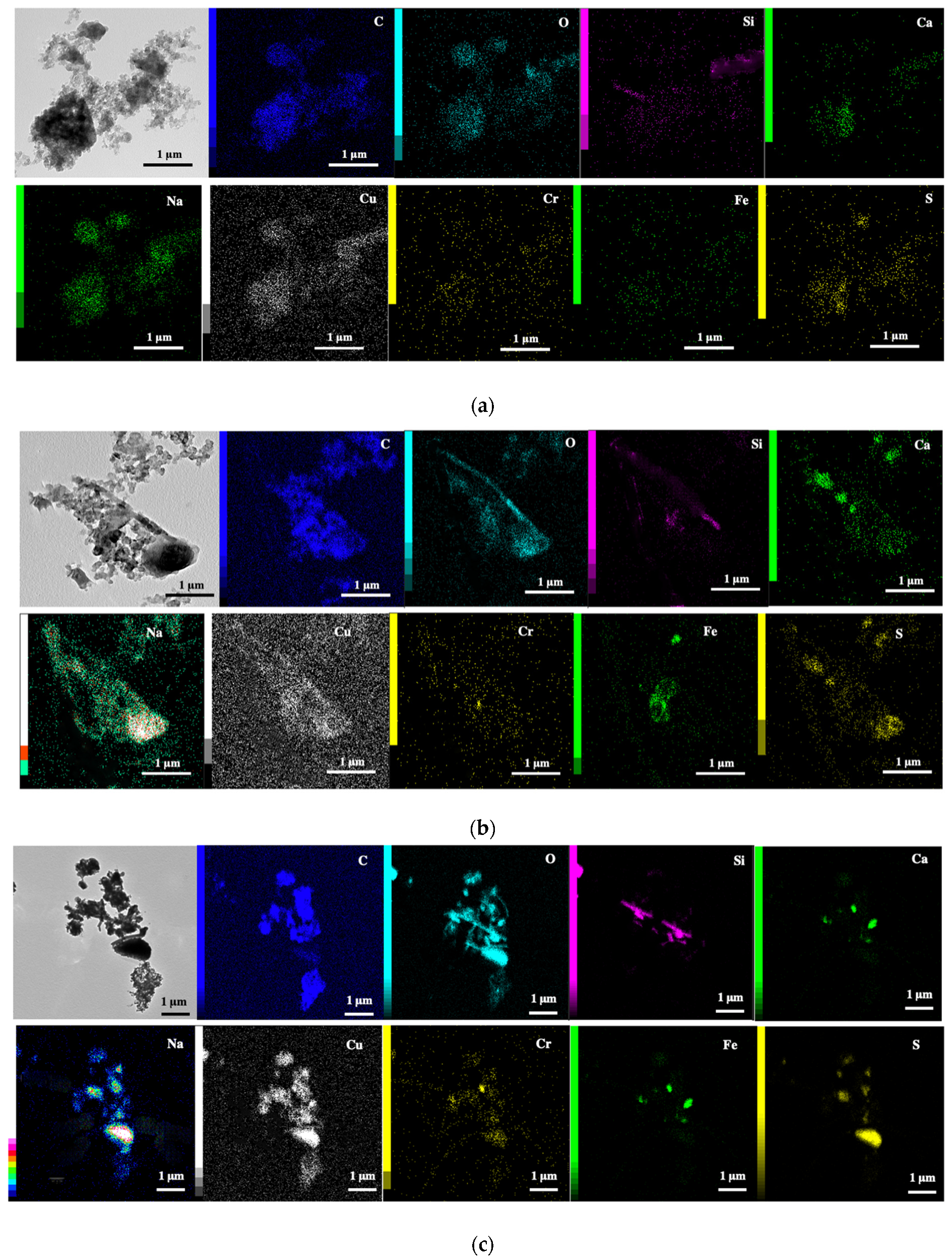
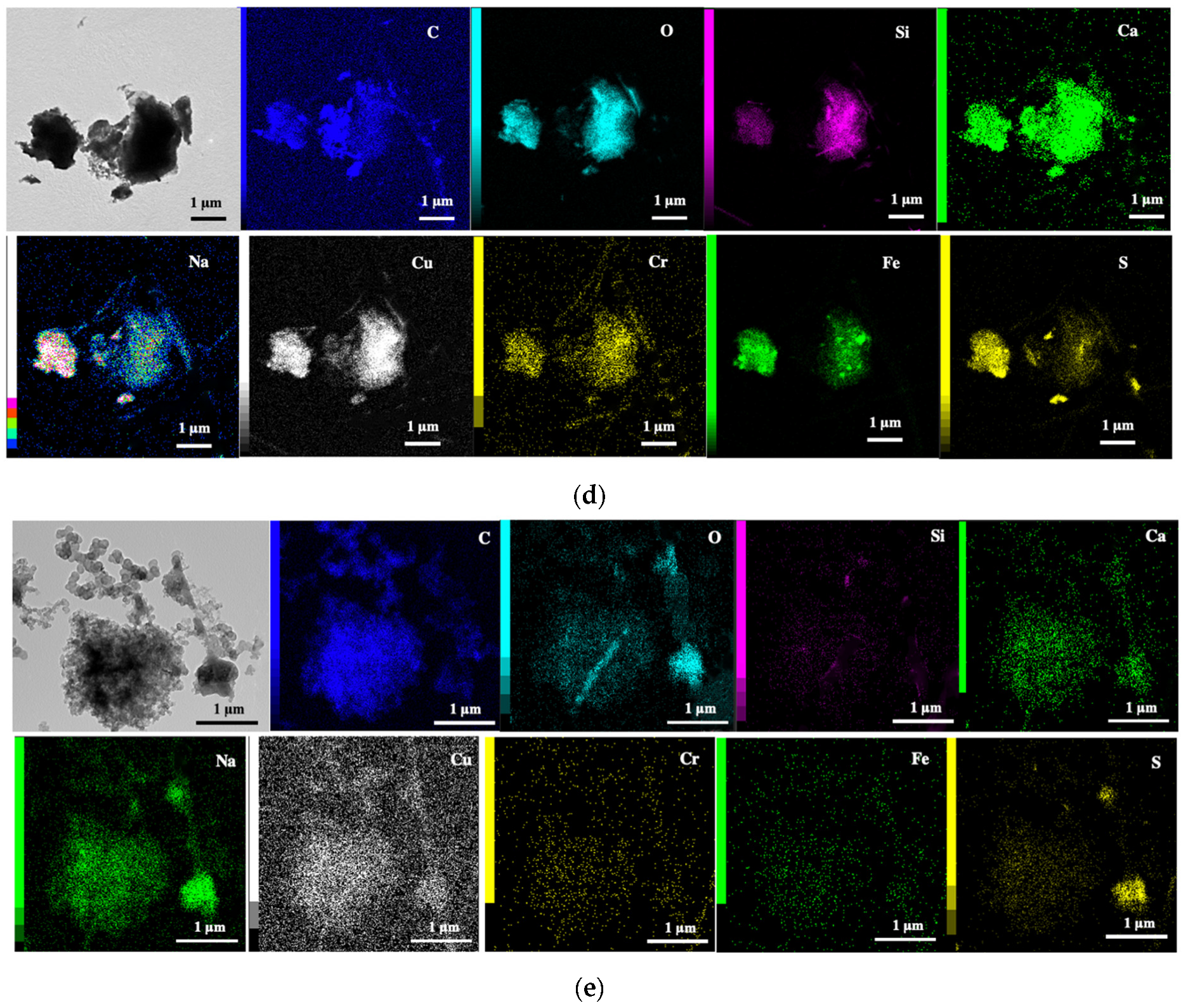
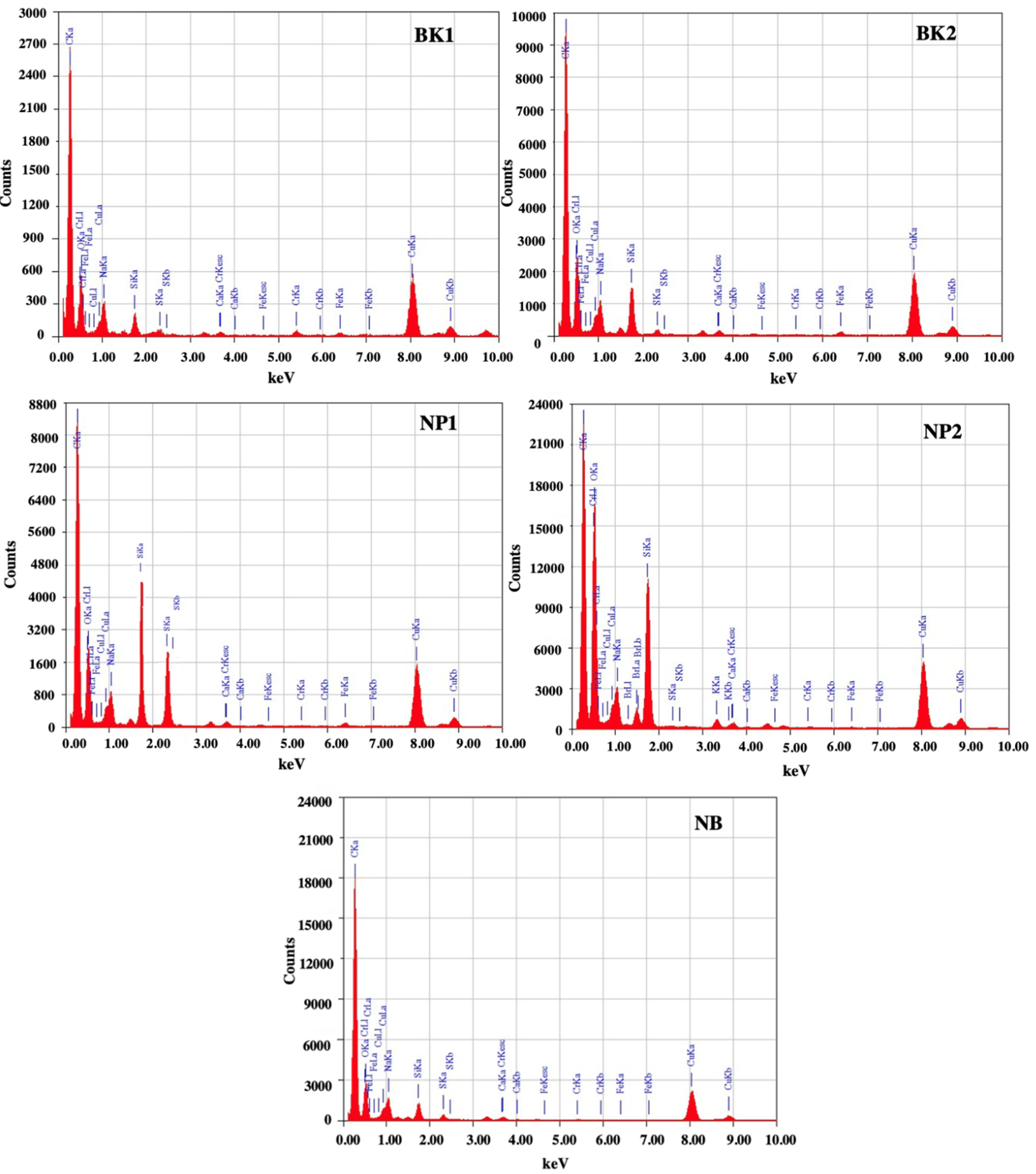
| Site | Average Concentration (µg/m3) | References |
|---|---|---|
| Bangkok, Thailand | 57 | This study |
| Nonthaburi, Thailand | 42 | This study |
| Nakhon Pathom, Thailand | 40 | This study |
| Rayong, Thailand | 16 | [17] |
| Kathmandu, Nepal | 822 | [18] |
| Arak, Iran | 50 | [19] |
| Charsadda, Pakistan | 254 | [20] |
| Khyber Pakhtunkhwa, Pakistan | 208 | [20] |
| Shanghai, China | 149 | [21] |
| Sampling Sites | Elements (wt.%) | ||||||||
|---|---|---|---|---|---|---|---|---|---|
| C | O | Si | Ca | Na | Cu | Cr | Fe | S | |
| BK1 | 85.89 | 8.55 | 3.42 | 0.01 | 0.01 | 1.62 | 0.24 | 0.23 | 0.04 |
| BK2 | 85.60 | 7.69 | 5.22 | 0.01 | 0.01 | 1.21 | 0.03 | 0.21 | 0.04 |
| NP1 | 83.61 | 9.32 | 6.15 | 0.01 | 0.01 | 0.45 | 0.03 | 0.21 | 0.21 |
| NP2 | 73.22 | 11.28 | 13.49 | 0.01 | 0.01 | 0.66 | 0.09 | 1.15 | 0.09 |
| NB | 88.59 | 7.15 | 3.17 | 0.01 | 0.01 | 0.98 | 0.02 | 0.03 | 0.05 |
| S.D. | 5.95 | 1.62 | 4.21 | 0 | 0 | 0.46 | 0.09 | 0.45 | 0.07 |
Publisher’s Note: MDPI stays neutral with regard to jurisdictional claims in published maps and institutional affiliations. |
© 2022 by the authors. Licensee MDPI, Basel, Switzerland. This article is an open access article distributed under the terms and conditions of the Creative Commons Attribution (CC BY) license (https://creativecommons.org/licenses/by/4.0/).
Share and Cite
Kanjanasiranont, N.; Butburee, T.; Peerakiatkhajohn, P. Characteristics of PM10 Levels Monitored in Bangkok and Its Vicinity Areas, Thailand. Atmosphere 2022, 13, 239. https://doi.org/10.3390/atmos13020239
Kanjanasiranont N, Butburee T, Peerakiatkhajohn P. Characteristics of PM10 Levels Monitored in Bangkok and Its Vicinity Areas, Thailand. Atmosphere. 2022; 13(2):239. https://doi.org/10.3390/atmos13020239
Chicago/Turabian StyleKanjanasiranont, Navaporn, Teera Butburee, and Piangjai Peerakiatkhajohn. 2022. "Characteristics of PM10 Levels Monitored in Bangkok and Its Vicinity Areas, Thailand" Atmosphere 13, no. 2: 239. https://doi.org/10.3390/atmos13020239
APA StyleKanjanasiranont, N., Butburee, T., & Peerakiatkhajohn, P. (2022). Characteristics of PM10 Levels Monitored in Bangkok and Its Vicinity Areas, Thailand. Atmosphere, 13(2), 239. https://doi.org/10.3390/atmos13020239






